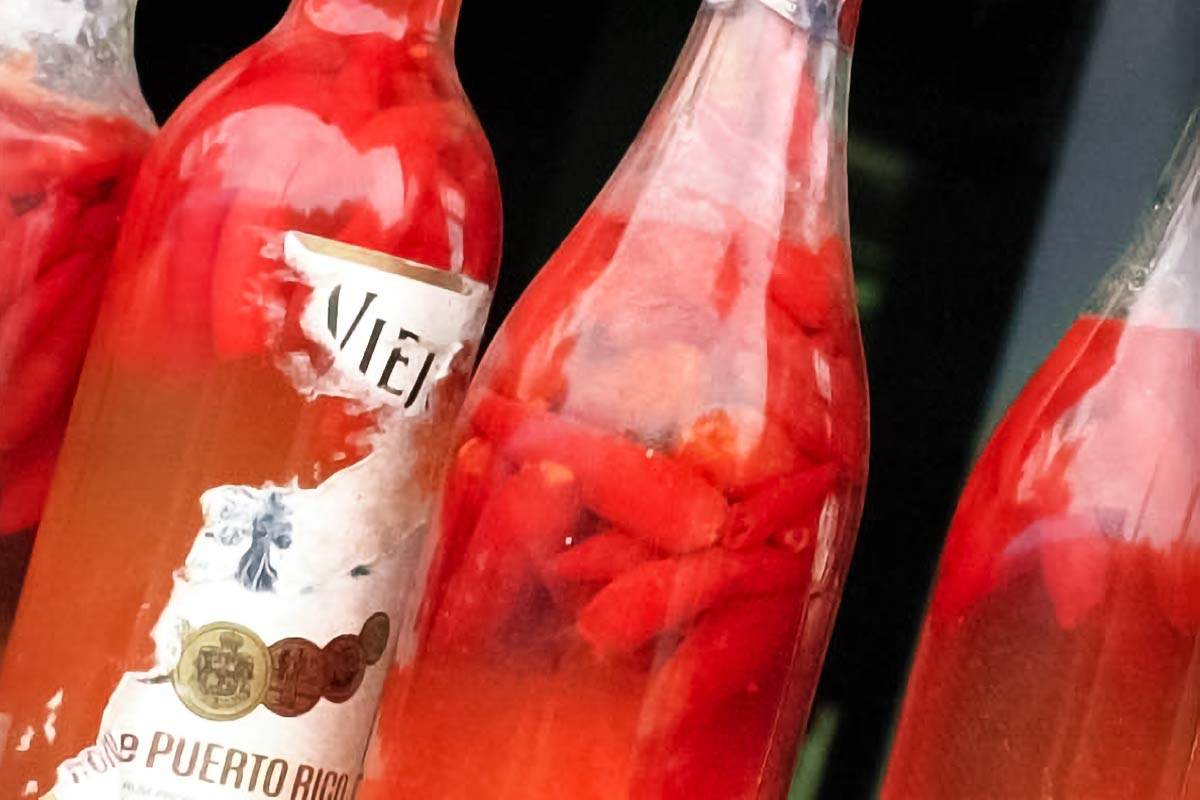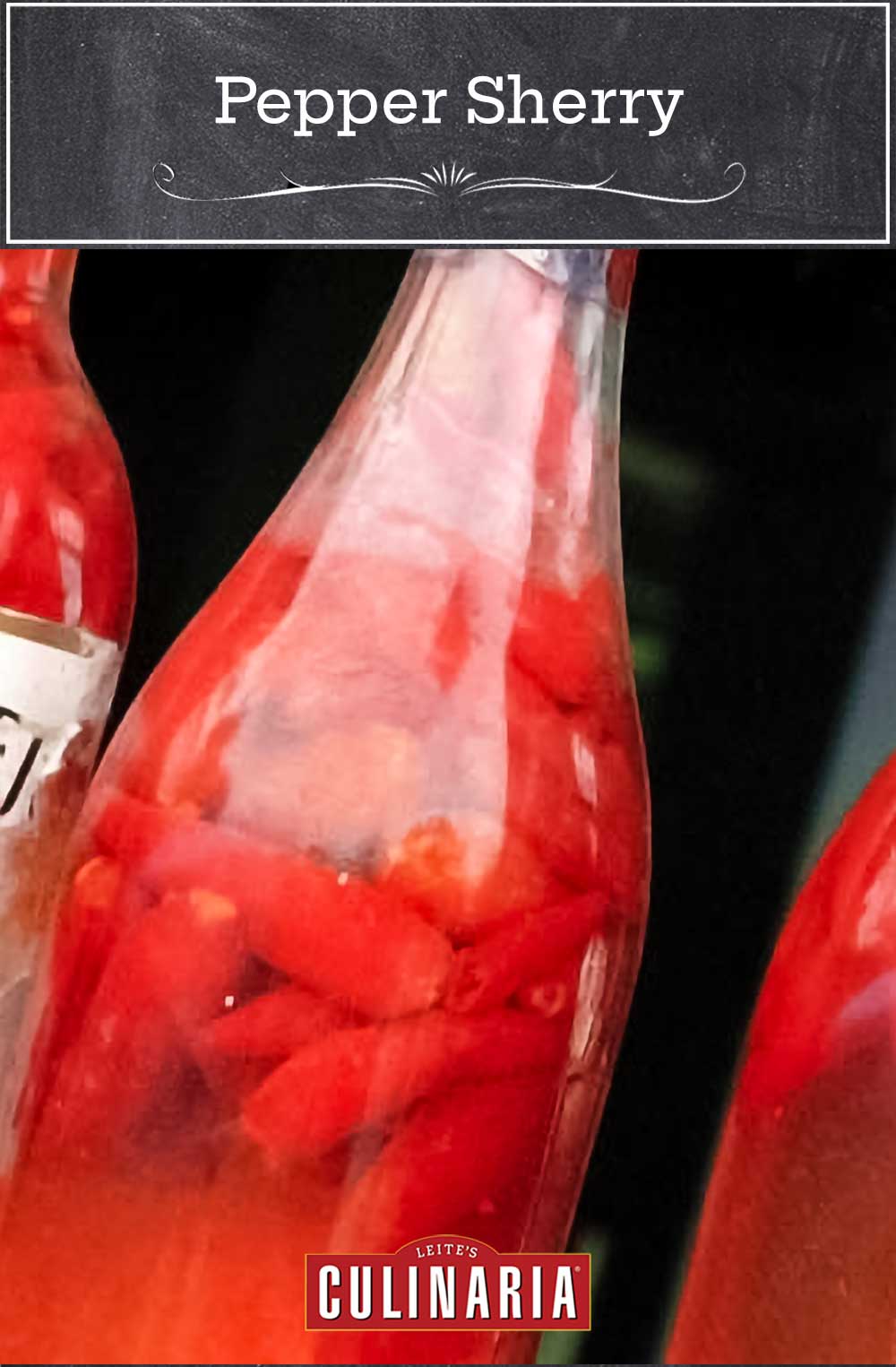
Plop some hot peppers in a bottle of booze and set it aside for as long as you can resist. What could be easier? Or more versatile! We’re dribbling this over and into beans and rice, stews and soups, fish tacos. Just don’t take a swig of it. And, as author Virginia Burke recommends (because we know you’ll be tempted), “If you succumb to temptation and eat the pepper, you can always add another one to the sherry later.”–Renee Schettler

Pepper Sherry
Ingredients
- 3 whole hot peppers, scrubbed, rinsed, and patted dry
- One (26-ounce) bottle sherry or rum
Instructions
- Remove the stems from the peppers and halve them or prick them with a fork or skewer.
- Pack your peppers into a clean mason jar and cover with sherry (or rum) and screw on the lid. If the peppers are slender enough, you can simply slide them into the bottle of booze (you may have to remove some of the liquor) and cap.
- Let sit for up to a week before using. Keep in a sealed bottle in the fridge for up to six months.
Notes
*What kind of chile peppers can I preserve in sherry?
This recipe is a little vague, we know. But therein lies the beauty of it. Use what you like, or have on hand, or what tickles your fancy at the market. Search out something hot or mild or fruity, that’s all up to you. You can use any pepper that will fit into your chosen vessel–a small bottle will take a whole handful of small peppers. A mason jar might take 3 or 4 big ole peppers. Mix and match to your heart’s content. A good way to decide is to look at the container you want to use and then pick your peppers from there, Peter Piper.
Nutrition
Nutrition information is automatically calculated, so should only be used as an approximation.
Recipe Testers’ Reviews
Think of all the wonderful things you can do with and to this. First of all, you can change the subtle taste of “hot” by choosing different peppers with which to experiment. I used yellow chile peppers for one batch and California serrano peppers for another batch. I elected to try the recipe using the rum instead of the sherry. And now I’m waiting to let each batch sit a while so that they really rock and roll. They’re both fairly tame right now, but good. I plan to use one or the other in black beans with rice.
It is an old tradition around here—meaning New Orleans—to have a bottle of hot peppers in vinegar or another spirit on the table next to the S&P and the Louisiana Gold Hot Sauce. Pepper Sherry how do we love thee—let us count the ways. Grillades and grits? Check. Bloody Mary? Check. Beans and rice? Check. Fried chicken? Check. Buffalo wings? Check. And best of all—slice a pepper and plaster it in between layers of a great muffaletta. OH YES!
This was delicious. I used Tio Pepe Palomino Fino (extra dry). I soaked them in the bottle itself in the fridge for 48 hours before I first tried it straight up. I did drink it straight because a winery in the Okanagan (British Columbia) makes a fruit wine with a hot pepper in it so it starts off sweet and then has a kick and this reminded me of it.
I make a sherry chicken dish in a cast-iron pan with vegetables and it calls for 1/2 cup of sherry. I usually make this in the Fall/Winter but I gave it a go now using this sherry and it was absolutely fabulous. It gave a nice sherry flavour but with a bit of a kick. Just enough of a kick to compliment the chicken and vegetables. I can’t imagine making this dish with just regular sherry. This is now a must-have come the fall season.













I let my peppers ferment in a sealed and upside down bottle at lower room temp for a month or so. I then strain out the peppers (I use bird’s eyes chilies) and any seeds and put back into a sterile bottle, cap, and store on the counter or in a cool closet.
I’m 70 years old and been making this condiment since I was 7 years old. I grew up in Maine and the Maritime community (especially friends from Nova Scotia) used it all the time.
That’s amazing, Joann. Thanks so much for taking the time to comment.
Is it important to ensure the peppers are always submerged in the sherry? In other words, if the raw peppers are exposed, is there a chance of mold forming on the exposed portion? I have only made pepper sherry with processed peppers, but I now have some really hot fresh from the garden peppers to use up. thanks.
Penni, yes, ideally you want to keep those peppers covered at all times. Leaving the jar sealed in the fridge will also help to avoid mold.